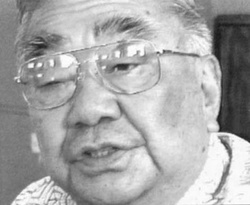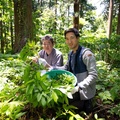The 100th was Formally Organized
When the war started, the Niseis who were drafted were already in two Hawaiian National Guard Regiments, the 299th Infantry and the 298th Infantry… The day the war started, they were already deployed because most army and federalized National Guard Units were already on alert… When the war started, they stayed with their respective National Guard Units. And as I understand it, during the battle of Midway, there was some concern about the Niseis who were with these federalized National Guard troops out in the field might cause some problems. So…they gathered all of the Niseis in those units and formed what they called the Hawaiian Provisional Infantry Battalion…
As a reserve officer I got into the service right after the war started. And I was assigned to the 299th Infantry. So I was also pulled in with the rest of the draftees to join this Provisional Battalion. Then we were shipped out to Oakland, CA…during the trip over, they informed us that we were to be called the 100th Infantry, separate. We landed in Oakland and we took trains—1,350 of us, I guess—three trains and we took different routes, but we all ended up in Camp McCoy, Wisconsin. And it was there that the 100th was formally organized as an infantry unit…
Then in January of 1943, the unit was shipped out of Camp McCoy, Wisconsin to Camp Shelby, Mississippi. And there our role was to take part in maneuvers out in Mississippi, Louisiana, and even Texas with other units… And the army determined that we were ready to be shipped out some time in July of 1943…
Well Those Are the Orders
We were ordered to go down and attack Cassino… Our first attack was a disaster. We had not received any reinforcements, replacements. My company strength was down to forty-six—four officers, and the rest enlisted men…after the 36th Division failed to cross the Rapido River on two occasions to our left, we were then ordered to frontally attack the flats right on the east side of the Cassino, and it was quite a task because the Germans had flooded the plains there… They cut down all of the trees. And they demolished all of the buildings, so actually, if there ever was a scene that depicted World War I, trench warfare, that was the place…the enemy had fortified the area to the extent of having artillery fire, mortar fire, machine gun fire, minefields laid right in front of the wall…
My company, B Company, was ordered to go across the flats in broad daylight and they told us to carry ladders because you need ladders to go across the wall, over the concertina barbed wire and then across the flats and over the next wall. Well, our Battalion Commander refused to give the order. He was relieved. They sent another officer down and he said it can’t be done. And they…the original Battalion Commander was reassigned the task and ordered to send B Company across the flats… When I got the order, we said, “Well, we’ll go along with what you say Major.” And he said, “Well these are the orders.” So I got together with our platoon leaders and gave them the story. Told them what the chances were and I said, “It’s up to you guys. If you fellas want to go ahead, we’ll try.” They said, “Let’s try.” And we did try and forty-six of us started the attack and by the time the attack was over, three officers and eleven men reached the wall. The rest of them were either killed, wounded, or stuck in the mud flats.
Go Ahead and Get It Done With
Q: Can you…describe what combat was like, especially under heavy fire?
It is hard to describe. It’s a feeling that—you’re scared. Everybody, scared, you know. And you got to move forward, you got to overcome that fear. And once they start moving, they overcome that fear and they build up the courage and move forward. But if you’re sitting still and waiting, that’s the worst time when you’re able reflect on what might happen. And so you know, you get very careful. But once you start moving forward, and especially if you’re successfully moving forward. That fear gives way to the real fighting…spirit, yeah. And you want to go ahead and get it done with. So I think if you want to describe any kind of emotion, it’s primarily fear of getting wounded or getting killed. And that’s an awesome feeling. But you can overcome that.
They Were Very Close to Each Other
Q: Why do you think they (the 100th Infantry Battalion and the 442nd Regimental Combat Team) were so distinguished?
First of all, I think the fact that we were a segregated unit…all Japanese Americans. There was closeness among all us and most of the fellas in the 100th were from Hawai‘i, there were just a few from the mainland. The 442nd there were quite a few from the mainland United States. Those in the 100th were all from Hawai‘i, except for a few. And many of them knew each other. They played with each other, they went to school together, so they were very close to each other. And they, they worked very well as a unit. And of course, we all felt they same way, that not only should we do well in combat, but we should also remember that we have to do well in order to…you know, erase some of the discriminating implications of the Japanese as well as the Isseis here in Hawai‘i.
A Stupid General
Q: You were an American of Japanese ancestry and yet America was at war with Japan. How did you feel about that? How did others, non-Japanese Americans feel toward you?
As far as I’m concerned, my personal experience—I know there’s discrimination, but I ignored it. For instance…when I was on duty on the island of Kauai before I joined the 100th…[t]here a was a general who…issued a general notice saying that none of the Niseis would be allowed to visit parents who were not American citizens. Well, you know, we completely ignored that, because we felt that this guy was a stupid general—so what, if we get caught, we get caught. But we’re not gonna ignore our parents just because this guy from New York has this bias.
We Were As Good As Any Other American
Q: What would you leave with future generations in terms of the experience of the 100th?
Well, I can say that most of us fought for the United States because of our love for our country. We were born and raised here and we were taught what democracy is, what it is to be an American. We participated—the draftees, you know, like any other draftee, we’d grumble because of the discomforts and the things that they suffered. But, I think they fought for the country because they love the country. They were loyal to the country. Secondarily, they knew that there was a lot of discrimination, not only to the Japanese people here, Japanese Americans and the older Niseis, but the discrimination of other racial groups, and one of the ways in which we can mitigate against or reduce discrimination, which is still going on, was to show the people that we were as good as any other American, and if need be, we’ll fight again and I hope future generations feel the same way.
*This article was originally published in the Japanese American National Museum Quarterly, Summer 1996.
© 1996 Japanese American National Museum







